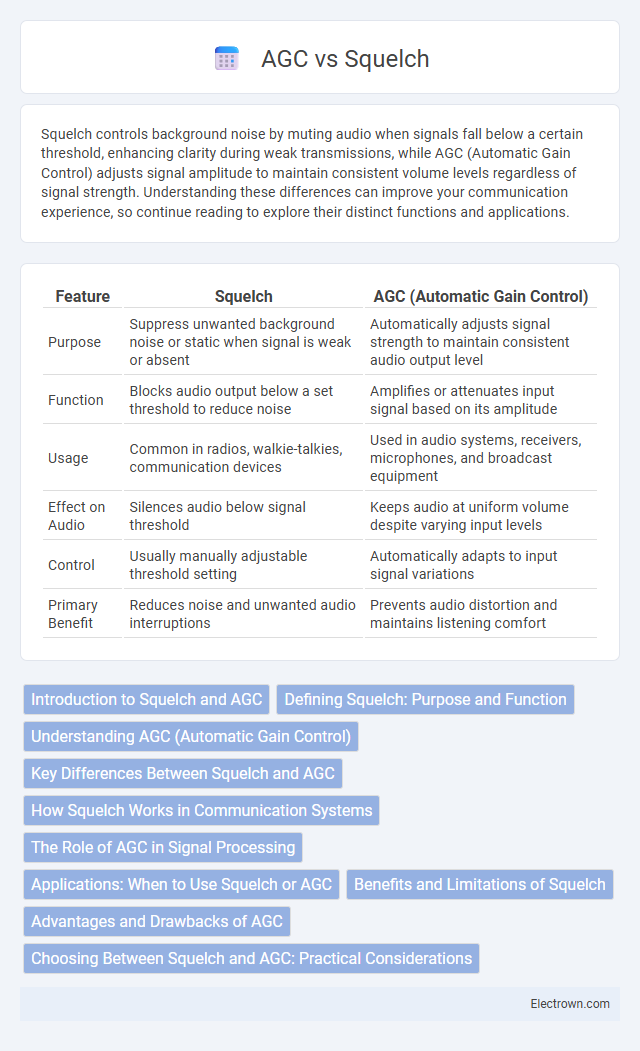Squelch controls background noise by muting audio when signals fall below a certain threshold, enhancing clarity during weak transmissions, while AGC (Automatic Gain Control) adjusts signal amplitude to maintain consistent volume levels regardless of signal strength. Understanding these differences can improve your communication experience, so continue reading to explore their distinct functions and applications.
Table of Comparison
| Feature | Squelch | AGC (Automatic Gain Control) |
|---|---|---|
| Purpose | Suppress unwanted background noise or static when signal is weak or absent | Automatically adjusts signal strength to maintain consistent audio output level |
| Function | Blocks audio output below a set threshold to reduce noise | Amplifies or attenuates input signal based on its amplitude |
| Usage | Common in radios, walkie-talkies, communication devices | Used in audio systems, receivers, microphones, and broadcast equipment |
| Effect on Audio | Silences audio below signal threshold | Keeps audio at uniform volume despite varying input levels |
| Control | Usually manually adjustable threshold setting | Automatically adapts to input signal variations |
| Primary Benefit | Reduces noise and unwanted audio interruptions | Prevents audio distortion and maintains listening comfort |
Introduction to Squelch and AGC
Squelch is a circuit function that mutes audio output in a radio receiver when the signal strength falls below a set threshold, preventing unwanted noise or static. Automatic Gain Control (AGC) automatically adjusts the receiver's gain to maintain a consistent audio level despite varying signal strengths. Both technologies enhance communication quality by managing signal reception but operate through distinct mechanisms: squelch controls audio muting, while AGC regulates signal amplification.
Defining Squelch: Purpose and Function
Squelch is a key feature in radio communication systems designed to mute the audio output when a signal falls below a certain threshold, reducing unwanted background noise or static. Its primary purpose is to improve the listening experience by allowing only signals above a set strength to be heard, ensuring clearer audio reception. You can adjust squelch settings to filter out weak or irrelevant signals, enhancing communication efficiency in noisy environments.
Understanding AGC (Automatic Gain Control)
Automatic Gain Control (AGC) is a vital feature in audio and communication systems that automatically adjusts the signal amplitude to maintain a consistent output level despite varying input signal strengths. Unlike squelch, which mutes audio below a certain threshold to suppress noise, AGC optimizes audio clarity by dynamically amplifying weak signals and attenuating strong ones. This ensures clear and stable audio reception, particularly in environments with fluctuating signal conditions.
Key Differences Between Squelch and AGC
Squelch controls the audio output by muting unwanted background noise when signal strength falls below a set threshold, enhancing clarity during weak transmissions. Automatic Gain Control (AGC) adjusts the receiver's gain dynamically to maintain consistent audio volume despite varying signal strengths. Unlike AGC, which stabilizes volume levels, squelch primarily filters out noise to prevent audio output during signal loss or interference.
How Squelch Works in Communication Systems
Squelch in communication systems operates by suppressing audio output when the received signal strength falls below a preset threshold, effectively minimizing background noise and static during weak or absent transmissions. It functions through signal level detection, allowing the receiver to remain silent unless a valid transmission exceeds the squelch level, which improves clarity and user experience in radio communications. This differs from Automatic Gain Control (AGC), which continuously adjusts receiver gain to maintain consistent audio levels regardless of signal strength.
The Role of AGC in Signal Processing
Automatic Gain Control (AGC) plays a crucial role in signal processing by dynamically adjusting the gain of a receiver to maintain a consistent output level despite varying input signal strengths. This ensures optimal audio quality and prevents distortion or noise caused by overly strong or weak signals. Unlike squelch, which mutes audio below a certain threshold to eliminate background noise, AGC actively manages signal amplitude for clear and stable reception.
Applications: When to Use Squelch or AGC
Squelch is ideal in radio communications to mute background noise when no signal is present, making it essential for clear audio reception in two-way radios and scanners. Automatic Gain Control (AGC) is best suited for audio processing in devices like hearing aids, microphones, and communication receivers, where maintaining consistent volume despite signal strength variations is crucial. Understanding your application helps determine whether squelch reduces noise effectively or AGC maintains audio clarity by adjusting gain dynamically.
Benefits and Limitations of Squelch
Squelch improves radio communication by automatically muting background noise and enhancing signal clarity, which enables users to hear only relevant transmissions. Its main benefit lies in reducing listener fatigue and preventing annoyance from static or weak signals, making it essential for two-way radios and public safety communications. However, squelch can limit reception by cutting off weak but important signals, potentially causing missed messages in critical situations.
Advantages and Drawbacks of AGC
Automatic Gain Control (AGC) offers the advantage of maintaining consistent audio levels by automatically adjusting the gain based on signal strength, improving listener experience in varying noise conditions. This feature helps prevent sudden volume spikes and reduces listener fatigue during extended use. However, AGC can introduce distortion or unnatural volume fluctuations in environments with rapidly changing signal strengths, which may compromise audio quality.
Choosing Between Squelch and AGC: Practical Considerations
Choosing between squelch and AGC depends on your specific audio environment and device requirements. Squelch eliminates background noise by muting the audio when the signal drops below a certain threshold, ideal for radio communications with intermittent signals. AGC automatically adjusts the audio signal strength, maintaining consistent volume levels in varying signal conditions, making it suitable for recording and broadcasting applications where audio clarity is essential.
Squelch vs AGC Infographic

 electrown.com
electrown.com